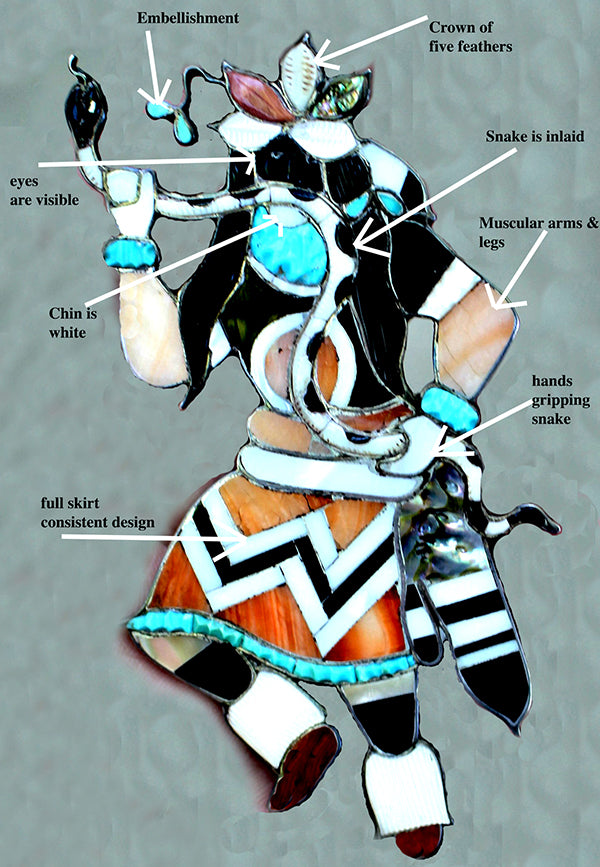The Leo Poblano Snake Dancer
Looking at the small black and white photo on page eighty-four of the famous C. G. Wallace sale catalogue from 1975, it is difficult to understand how this inlayed figure has become the iconic work of the master stone cutter Leo Poblano. But what is even more puzzling is how, sixty years after Poblano’s death, pieces following the basic design (or most any snake dancer at all) have multiplied into dozens and dozens [and dozens] of “Leo Poblano” pieces.
A quick side-by-side comparison of a yay and a nay example might help. Start with the snake. It is well documented that Leo Poblano never learned to solder or work silver. So an authentic Leo snake dancer should have an inlay serpent. The snake in the catalogue piece is a tour-de-force of design with the sinuous reptile ending in a tail that is almost an optical illusion as it twists on itself. Who gives a thought to how the twisting body changes the markings?

How about the mask? That was a trick question, since the snake dancer doesn’t wear a mask. The top half of the face is painted black, the chin appears white. Leo’s eyes are wonderfully spooky. Eyeballs don’t show through a katsina mask. Most imitators copy the dancer’s chin as a gorget and make it disproportionately large.
The feathers on the head are very distinctive. Leo used five feathers and a strange little fillip with what look like two leaves. The specimen in the catalog has one on each side. The one pictured here has the second one down on the dancer’s left shoulder, making it look like a hair tie.
One thing that sometimes makes identifying a Leo snake man is the fact that when Leo and Daisy Poblano moved to the southeast edge of the village, their only neighbors were the Edward Beyukas. Eddy made some snake dancers very similar to Leo’s but the feathers are different and the snakes are silver which allows them different configurations. Silver wire can be bent any old which way.

The single factor that separates the work of Leo and Eddy from the rest is quality. They are better balanced, perfectly finished, and excellently designed. That last may sound silly, but compare one of theirs with a fake. The one pictured here lacks dynamic motion, even the drape of the skirt is limp, not to mention the design of the kilt is all wrong. The diamonds are all different shapes and even the colors are inconsistent. Where did the black triangle come from?
And those scrawny, misplaced and structurally challenged legs are an insult to the artistry of Leo Poblano. Shame.
Another important element usually overlooked in bogus Leo attributions is the use of silver dividers between the stones. He only cut the stones, he did not do the silver work, so how were they determined?
I have had trouble with one particular item since the first Zuni Snake Dancer I ever saw. The authentic snake kilt pictures the plumed serpent and no other design. Of course that is a bit drab. But I suspect there is another reason, like because the serpent design is also sacred to the Zunis.
